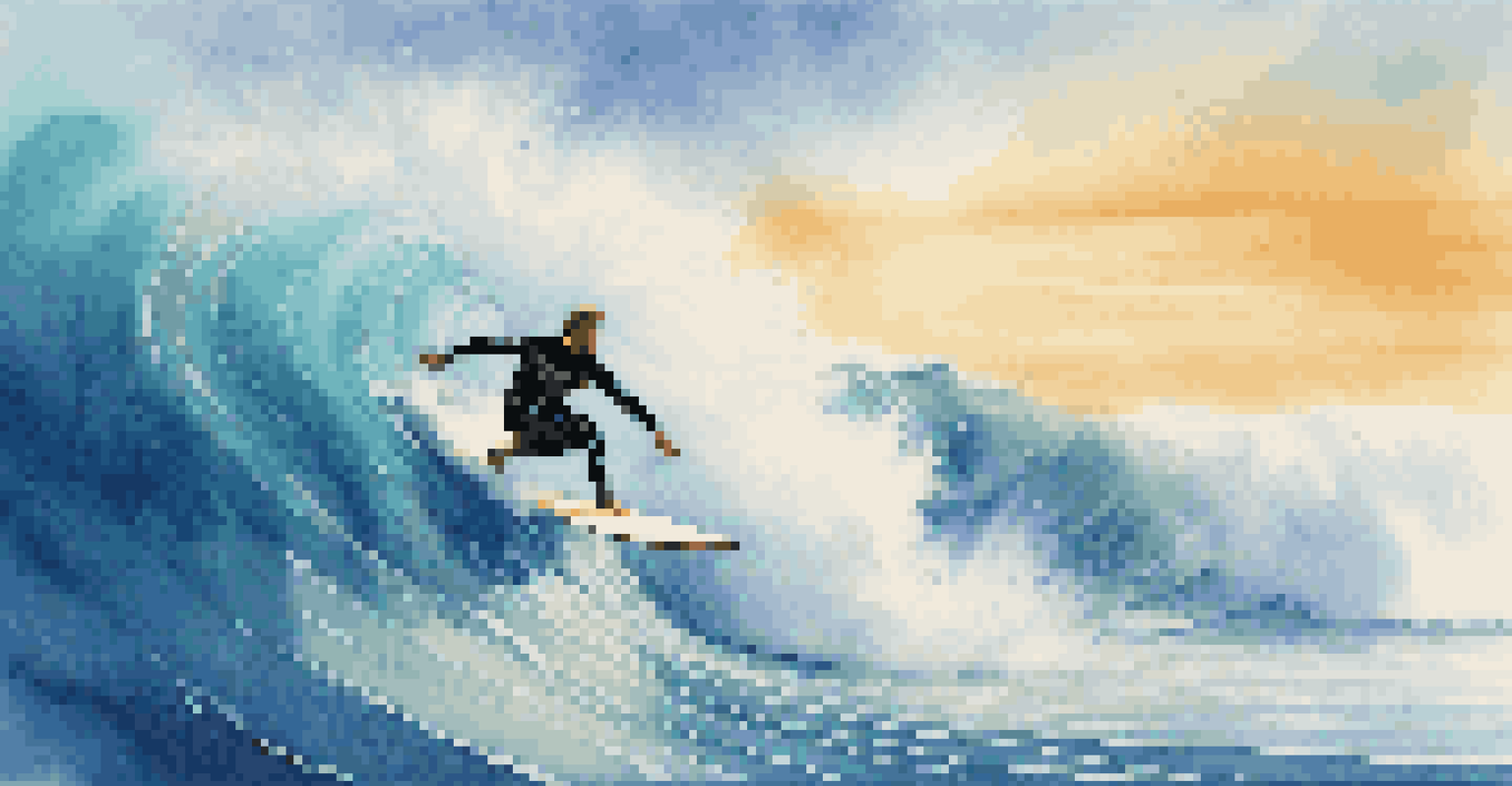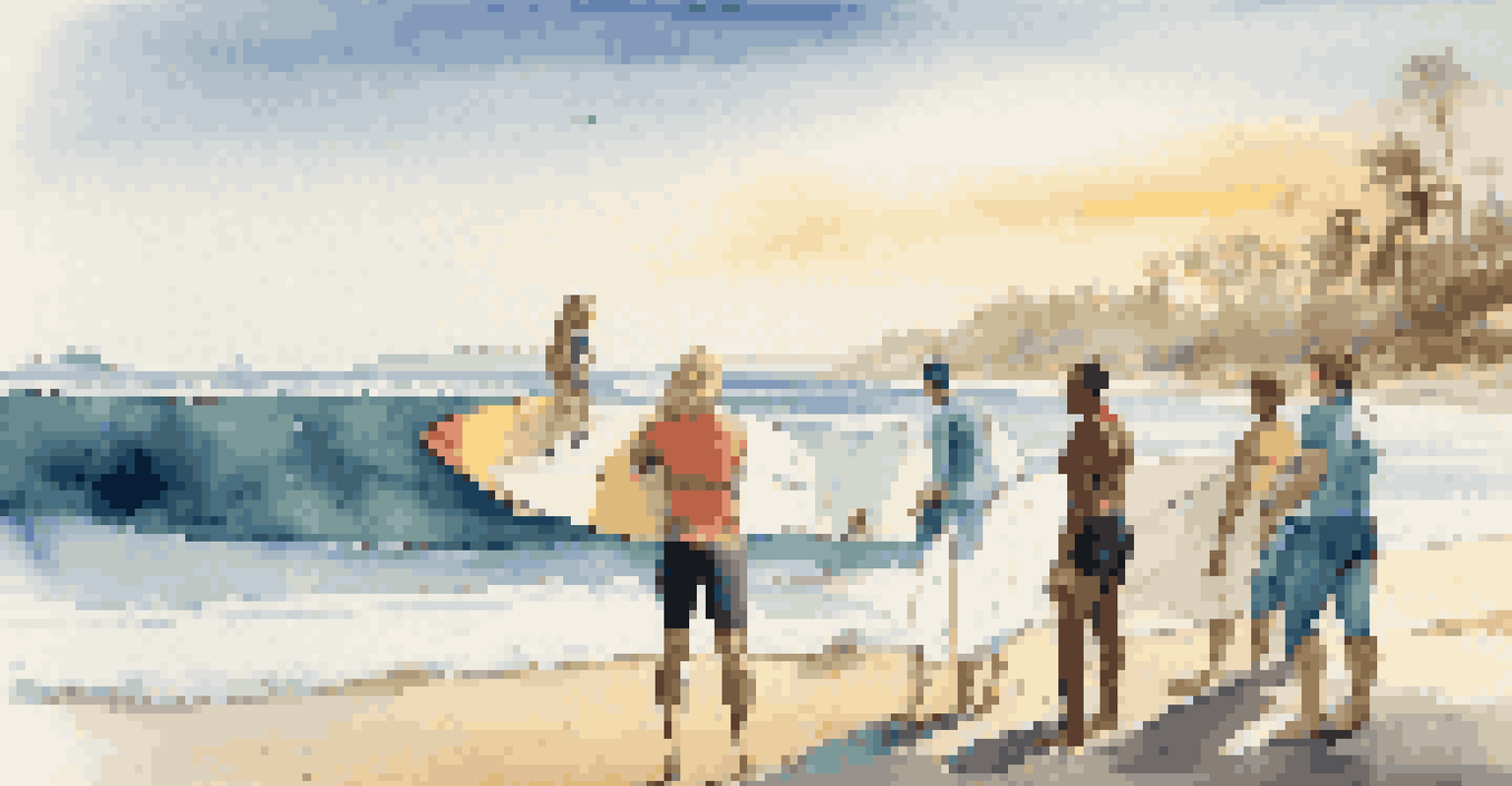Surfing Health Risks: Understanding Injuries and Prevention

Understanding Common Surfing Injuries
Surfing, while exhilarating, comes with its share of risks. Common injuries include cuts, bruises, and more severe issues like fractures or concussions. These injuries often result from falls, collisions with the board, or even other surfers. Understanding these risks is the first step in enjoying the waves safely.
Surfing is the most blissful experience you can have on this planet, a taste of heaven.
For example, a surfer might get a fin cut while paddling out, which can be painful and lead to infections if not treated properly. Similarly, the impact of a hard fall can cause ankle sprains or wrist fractures. Recognizing the types of injuries that can occur helps surfers remain vigilant and prepared.
Additionally, awareness of the surfing environment plays a crucial role in injury prevention. Factors like wave size, water conditions, and the presence of other surfers can significantly impact safety. By understanding these elements, surfers can better protect themselves against common injuries.
The Impact of Wave Conditions on Safety
Wave conditions can greatly influence the likelihood of injury while surfing. For instance, larger waves may provide thrilling rides but can also increase the risk of wipeouts and collisions. On the other hand, smaller, choppier waves might lead to more falls or misjudged maneuvers.

Surfers should always check the surf report and local conditions before hitting the water. This includes assessing wave height, current strength, and tide changes. Being informed allows surfers to choose safer days for their sessions and avoid dangerous conditions.
Injury Awareness is Crucial
Understanding common surfing injuries and their causes helps surfers stay vigilant and prepared.
Moreover, understanding how to read the ocean can help surfers navigate safely. Familiarity with riptides, rocky areas, and wildlife can prevent accidents. A knowledgeable surfer is often a safer surfer, making it essential to respect the ocean's moods.
Proper Surfing Gear and Equipment
Having the right gear is vital for reducing injury risks while surfing. A well-fitted wetsuit not only keeps you warm but also provides a layer of protection against scrapes and sunburns. Additionally, choosing a surfboard that matches your skill level can prevent accidents caused by improper handling.
The best surfer out there is the one having the most fun.
For instance, beginners may benefit from using a soft-top board, which is more forgiving during falls. On the other hand, experienced surfers might opt for a harder board for better performance. Choosing the right equipment based on your skill level and the conditions can enhance safety.
Furthermore, don’t forget essential accessories like surf leashes. A leash can prevent your board from becoming a hazard to you and others if you wipe out. Investing in quality gear not only enhances your performance but also significantly contributes to injury prevention.
Injury Prevention Techniques for Surfers
Injuries can often be prevented through proper technique and awareness. For example, practicing how to fall correctly can minimize the risk of injury during wipeouts. Learning to roll or tuck upon falling helps protect vital areas like the head and spine.
Additionally, warming up before surfing is crucial. Simple stretches and mobility exercises can prepare your body for the physical demands of riding waves. A well-prepared body is less prone to strains and sprains.
Wave Conditions Affect Safety
Being informed about wave conditions and learning to read the ocean can significantly reduce the risk of injuries.
Surfers should also consider taking lessons from experienced instructors. They can provide invaluable insights into safe practices and techniques. Learning from professionals can build your confidence and ensure you're surfing safely.
Recognizing Signs of Injury During Surfing
Being able to recognize the signs of injury while surfing is essential for your safety. Symptoms like pain, swelling, or difficulty moving a limb should never be ignored. If you notice any of these signs, it’s best to exit the water and assess the situation.
Moreover, some injuries may not be immediately visible, such as concussions or deeper cuts. If you feel dizzy, confused, or have a headache after a wipeout, seek medical attention. Surfing is about having fun, and ignoring injuries can lead to long-term issues.
Listening to your body is key. If you're feeling fatigued or in pain, it's wise to take a break. Surfing when you're not at your best increases the likelihood of accidents, so always prioritize your health and safety.
The Role of Surfing Communities in Safety
Surfing communities play a vital role in promoting safety among surfers. Local surf shops and clubs often provide resources, classes, and workshops focused on injury prevention. Engaging with these communities can enhance your knowledge and skills.
Moreover, experienced surfers often share their insights on local conditions and hazards. This communal knowledge can be invaluable for newcomers. When surfers look out for one another, it fosters a safer environment for everyone.
Community Enhances Surfing Safety
Engaging with local surfing communities fosters knowledge sharing and promotes safety among surfers.
Participating in community events or beach clean-ups can also strengthen bonds among surfers. A tight-knit community encourages open discussions about safety concerns and best practices, making it an essential element of surfing culture.
When to Seek Medical Attention for Surfing Injuries
Knowing when to seek medical attention for surfing injuries can be a game-changer. If you experience severe pain, swelling, or an inability to move any part of your body, it’s crucial to get professional help right away. Some injuries may seem minor at first but can lead to complications if left untreated.
Additionally, if you sustain a cut, especially from a fin or reef, it’s wise to have it checked. Infections can develop quickly in saltwater environments, so proper care is essential. Don't hesitate to visit a healthcare provider if you're unsure about the severity of an injury.

Finally, following up with a doctor after a significant injury is essential for a full recovery. They can provide guidance on rehabilitation and exercises to regain strength. Prioritizing your health ensures you can return to the waves safely and confidently.